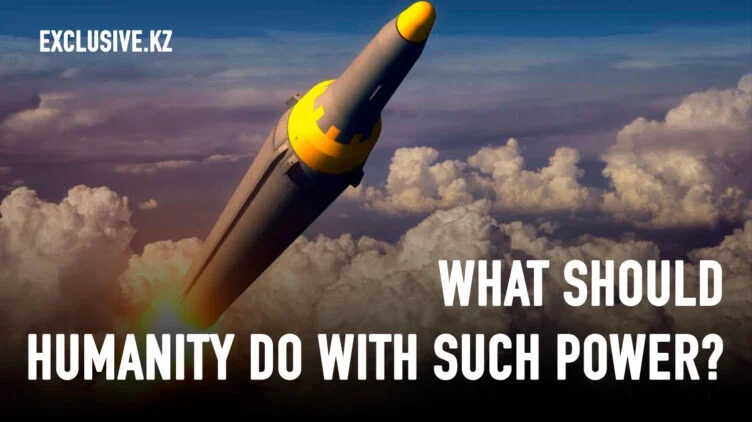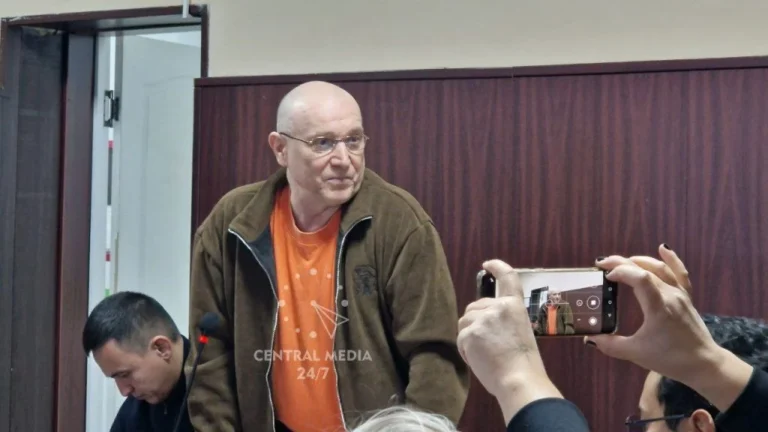The Nuclear Age Turns 80

A defining characteristic of nuclear weapons is their prolonged lethality. Many of those who died as a result of the atomic bombings of Hiroshima and Nagasaki lived for days, weeks, months, or even years before succumbing to internal injuries, severe burns, radiation sickness, or cancer.
Among the lesser-known casualties of August 1945 was an Armenian-American physicist named Harry Daghlian. A PhD student at Purdue University, Daghlian had joined the Critical Assembly Group at the Los Alamos Laboratory – part of the Manhattan Project – where a workplace accident exposed him to a fatal dose of radiation.
Tasked with finding the point at which a plutonium mass nears criticality – when fission becomes self-perpetuating – Daghlian accidentally dropped a tungsten brick onto the core, triggering a burst of neutron radiation that severely burned his hand and landed him in the hospital. The accident occurred on August 21, 1945, less than a week after Emperor Hirohito accepted the terms of Japan’s unconditional surrender. Twenty-five days later, Daghlian died of radiation poisoning.
The nuclear epoch has always been shaped by the interplay between cosmic forces and human foibles. At times, its course has resembled the structure of a Greek tragedy. How else can we explain a technology capable of turning a momentary slip into a slow, agonizing death, with the victim never seeing the invisible particles that sealed their fate?

Just one year after Daghlian’s death, the very same plutonium core claimed a second life, when physicist Louis Slotin triggered a lethal burst of radiation during an experiment gone awry. Thereafter, the mass came to be known as the “demon core,” capturing the eerie paradox at the heart of nuclear science: extraordinary precision, made possible through decades of rigorous theorizing and experimentation, animated by a seemingly supernatural, even diabolical, spirit.
The scientific manipulation of transuranic matter has long been overshadowed by two metaphysical questions: What should humanity do with such power? And what boundaries must not be crossed?
The 80th anniversary of the atomic bombings of Hiroshima and Nagasaki has prompted the release of three new books examining the trajectory and legacy of the Manhattan Project. These works trace the arc of nuclear history, from Wilhelm Röntgen’s discovery of X-rays in 1895, through Japan’s defeat in World War II and the detonation of the largest weapon ever tested – the Soviet Union’s Tsar Bomba – in 1961, to the evolution of international nuclear politics up to Russia’s current war of aggression in Ukraine. Together, they serve as a sobering reminder of the ironies that define the nuclear age, as well as the remarkable luck that only two atomic bombs have ever been used in warfare.
The Birth of “Big Science”
Frank Close’s Destroyer of Worlds focuses on the discovery of the atomic nucleus. An emeritus professor at the University of Oxford and a former head of theoretical physics at the storied Rutherford Appleton Laboratory, Close is a masterful guide to the scientific twists and turns that ushered in the nuclear age.
To be sure, this story has been told before, most notably in Richard Rhodes’s duology The Making of the Atomic Bomb(1987)and Dark Sun(1995), as well as in P.D. Smith’s Doomsday Men(2007). But Close’s account stands out for bringing the patience of a seasoned teacher to the arcane world of subatomic phenomena and experimental inference. His tenure as head of communications and public understanding at the European Organization for Nuclear Research (CERN) from 1997 to 2000 proved an ideal apprenticeship for a second career as a science writer.
Over the past two decades, Close has explored the history of physics and astrophysics in a range of books, from Very Short Introductions on nothingness and particle physics to engaging narratives about how we came to understand antimatter, neutrinos, and asymmetry. Along the way, he has produced a handful of biographies and historical sagas, most notably the story of Peter Higgs and the discovery of the infinitesimal particles that give rise to mass.
Destroyer of Worlds can be seen as the final installment in a trilogy. The first entry, Half-Life(2015), recounted the “divided life” of Bruno Pontecorvo, the Italian-Russian nuclear physicist who defected to the Soviet Union in the early 1950s. The second, Trinity (2019), chronicled the story of Klaus Fuchs, the infamous British scientist who passed secrets from Los Alamos to the NKVD, the KGB’s predecessor.
Unlike these previous works, Destroyer of Worlds is not a tale of wartime espionage or Cold War geopolitics but a transnational history of nuclear physics and chemistry between 1895 and 1960. The title, of course, references J. Robert Oppenheimer’s haunting recollection of the Trinity test, when he claimed to have quoted Vishnu’s lament from the Bhagavad Gita: “I am become death, the destroyer of worlds.” His brother Frank, however, remembered him simply exhaling and saying, “It worked.”
While much of the story is familiar, Close has a knack for analogy, rendering complex experiments and the abstractions of quantum mechanics accessible to lay readers. For example, he describes Ernest Rutherford’s early efforts to manipulate alpha-particle beams with magnetic fields, which provided evidence for the existence of the atomic nucleus and eventually earned Rutherford a Nobel Prize. Close likens the blurred beam edges to “a target jet of water from a high-pressure hose being converted into a fine spray,” enabling any reader who has watered a garden to feel as if they are standing at the lab bench beside Rutherford in his Manchester laboratory in 1907.
Close divides his narrative into four sections: the experiments that revealed the atomic nucleus, which took place between 1895 and 1913; the advances in experimental and theoretical physics and chemistry that led to quantum mechanics, culminating in James Chadwick’s discovery of the neutron in 1932; the discovery of nuclear fission and chain reactions in the years just before World War II; and finally, the development of nuclear and thermonuclear weapons through the Manhattan Project and into the early Cold War.
To help readers make sense of this complicated history, Close provides essential social and political context. For example, he examines how the rise of fascist and Nazi ideology disrupted European science, resulting in a wave of scientific talent fleeing to the United Kingdom and North America.
One particularly fascinating, albeit lesser-known, figure is Ettore Majorana, an Italian physicist whom the brilliant Nobel laureate Enrico Fermi once compared to Isaac Newton and Galileo. Majorana was a key member of the close-knit group of Italian physicists who made foundational contributions to quantum theory. His most famous legacy is an equation predicting particles that act as their own antiparticles, now known as “Majorana fermions.”
Majorana was also a member of the Italian Fascist Party, and his 1938 disappearance under mysterious circumstances remains the subject of intense speculation. The Italian government did not officially close his case file until 2015, and debate persists over whether he committed suicide, was murdered, or secretly fled to Venezuela.
But what drives Close’s narrative is the work itself: the curious minds and research laboratories where the process of scientific discovery played out. He excels at bringing the lab to life, from the earliest primitive experiments to the ever-larger and increasingly expensive machines that have come to define the era of “big science.” In one comic episode, Rutherford and his colleague Hans Geiger, inventor of the Geiger counter, take turns behind linen screens, counting alpha particles striking a zinc-sulphide target – a process so tedious it becomes the radioactive equivalent of watching paint dry.
Within just 25 years, the pace of discovery had accelerated dramatically. John Cockcroft and Ernest Walton were building new types of electric generators to power the world’s first particle accelerator. In Berkeley, California, Ernest Lawrence expanded on their work to develop even more powerful cyclotrons, the spiritual ancestors of high-energy research centers like CERN.
Oppenheimer, Lawrence’s colleague at Berkeley, would later lead the Los Alamos National Laboratory, where, on July 16, 1945, modern nuclear physics reached its violent apotheosis with the detonation of the world’s first atomic device.
How Cities Became Strategic Targets
Hiroshima and Nagasaki were targeted three weeks after the Trinity test, on August 6 and 9, respectively. In the decades since, historians have raised a litany of questions: Were the bombings necessary, given Japan’s already dire circumstances? Could President Harry Truman have softened his policy of unconditional surrender? How did the impact of these nuclear strikes compare to the US naval blockade, its strategic bombing campaign, and Stalin’s August 8 declaration of war on Japan? And above all, were they morally justified?
Richard Overy’s Rain of Ruin offers a framework for understanding these questions by placing the increasingly indiscriminate use of airpower in the Pacific Theater within the broader context of a brutal and totalizing war. This interpretive lens is not entirely new. The United States Strategic Bombing Survey, completed in 1946, and Michael Sherry’s landmark 1987 study The Rise of American Air Power both observed how closely targeting and outcomes aligned during the war, regardless of whether the ordnance was conventional, incendiary, or atomic.
Overy, one of the foremost living historians of World War II, builds on his career-long engagement with the uses and abuses of airpower. In his 2014 book The Bombers and the Bombed, he adopted a skeptical but not dismissive stance toward the British and American air campaigns against the Third Reich. While he rejected the Strategic Bombing Survey’s conclusion that these campaigns had been decisive, he acknowledged their indirect effects, such as forcing the Luftwaffe to redeploy forces back to Germany to conduct defensive missions.
Rain of Ruin is a masterclass in interpretive history. While Malcolm Gladwell’s bestselling 2021 audiobook The Bomber Mafia covers similar ground, Overy’s deep expertise is evident in his attention to context, particularly the broader Pacific War and the political dynamics within Japan.
Overy traces the evolution of Anglo-American thinking on “area bombing,” noting how early Luftwaffe attacks on civilians in Poland, the Netherlands, and the UK influenced Allied attitudes toward strategic bombing. Once Japan’s surprise attacks on Pearl Harbor and the Philippines drew America into the war, the US Army Air Forces began applying the doctrine developed by Brigadier General William “Billy” Mitchell in the 1920s and 1930s, which emphasized the use of long-range bombers to destroy vital centers of industrial production, transportation, and economic infrastructure, such as rail hubs and oil refineries.
By contrast, British Air Marshal Arthur Harris focused on enemy morale – an amorphous target first championed by the Italian General Giulio Douhet, who advocated “knock-out blows” against vulnerable population centers.
The risks of this strategy were extreme. The US Eighth Air Force lost 26,000 airmen in combat, with as many as 120 B-17 bombers downed in just two missions over Schweinfurt. These losses forced a pause in deep-penetration raids until the arrival of long-range P-51B Mustang escort fighters in early 1944.
The introduction of the long-range B-29 Superfortress brought American strategic airpower into the Pacific Theater. Early attempts to launch bombing runs from Allied-controlled airstrips in China proved untenable, as the bases were primitive and vulnerable to Japanese counterattacks. It wasn’t until the summer of 1944, following the US advances across the Central and South Pacific under Navy Admiral Chester Nimitz and General Douglas MacArthur, that the seizure of the Mariana Islands placed the Japanese home islands within range of B-29s.
The transition to high-quality airfields on Tinian, Saipan, and Guam – combined with the replacement of Brigadier General Haywood Hansell by Major General Curtis E. LeMay, who felt far fewer compunctions about causing collateral damage – brought the war home to Japan with growing intensity.
From the outset, the Pacific air campaign was designed to hit economic targets: coke furnaces, transport hubs, aircraft manufacturing, and “industrial and urban areas.” The effects were catastrophic. Japanese civilians, already enduring the hardships of a tightening naval blockade, now faced regular bombings, both conventional and – as of March 9, 1945 – incendiary.
That night, Operation Meetinghouse unleashed firestorms that reduced 16 square miles of Tokyo to an ash-covered abattoir and claimed the lives of 80,000-100,000 civilians, “the largest number of civilians killed on any one day in all the wars of the twentieth century.” More than one million were left homeless. From that point until the war’s end, firebombing would kill an estimated 250,000 people.
These infernos were the direct result of LeMay’s decision to load the XXI Bomber Command’s magazines with M-69 incendiary clusters filled with napalm. He justified this approach as a brutal military necessity: a commander’s duty, he believed, was to win battles “without exterminating too many of our own folks.” It was not for nothing that LeMay himself later remarked that if the US had lost the war, he would have been tried as a war criminal.
An Unnecessary Experiment?
Overy, for his part, largely avoids moralizing, encouraging readers “not to judge the past but to try to understand it better on its own terms.” He entertains the possibility that the US Army Air Forces turned to increasingly indiscriminate tactics to demonstrate their future usefulness as an independent military branch. Moreover, the dispersion of Japanese industry into small workshops and private homes, along with the colocation of workers’ residences with major factories, made precision bombing exceedingly difficult, even under ideal conditions.
Still, the implications were well understood. When the Office of Strategic Services offered guidance on how to exploit the flammability of Japanese cities, fully built-up residential areas were given the highest priority, just ahead of “mixed residential-industrial” zones. With the Pacific descending into total war and each side dehumanizing the other, the moral boundaries became increasingly blurred. As David E. Lilienthal, the first chair of the US Atomic Energy Commission, later observed, “There are no individual combatants. The fences are gone.”
By the summer of 1944, most Japanese military leaders, including Emperor Hirohito, had come to understand that the war was lost. Yet they continued to hope for one final victory that could strengthen their negotiating position, allowing them to retain Japan’s colonial holdings in Korea, Taiwan, and China, or at the very least, preserve the Emperor’s sacred authority over the Japanese national polity (kokutai).
The Battle of Leyte Gulf (in October 1944) laid bare the futility of further resistance, but Japan’s leadership refused to accept unconditional surrender. Meanwhile, the US naval blockade had slashed Japanese imports from a high of 20 million tons in 1941 to just 2.7 million – most of it food – by 1945. Efforts by Prince Fumimaro Konoe’s peace faction to pursue Soviet mediation collapsed in the face of Stalin’s own territorial ambitions in Manchuria, southern Sakhalin, the Kuril Islands, and Port Arthur.
Were the bombings necessary, and were they morally justified? Overy suggests that from an ethical standpoint, the atomic bombings were not fundamentally different from the conventional attacks that had preceded them. Much of the death and destruction in Hiroshima and Nagasaki, after all, was the result of thermal effects similar to those caused by firebombing raids.
Overy’s suggestion that firebombing may have made the nuclear option more psychologically palatable, however, goes beyond the available evidence. The simple truth is that once atomic weapons proved feasible, their use was all but assured. The $2 billion spent on the Manhattan Project (equivalent to $36 billion today) had been earmarked to furnish a weapon to defeat Nazi Germany and, following its defeat, Imperial Japan. Overy is on firmer ground when he points out that targeting entire cities – “whether by conventional or nuclear attack” – remained central to US air strategy in 1945.
Morality often depended on one’s vantage point. For American infantrymen preparing for amphibious assaults against an enemy backed into corner, survival was paramount. Estimates of American casualties in a full-scale invasion varied widely, ranging from tens of thousands to as many as one million. Japanese resistance was expected to be as fanatical as it had been throughout the war. The Battle of Okinawa, which claimed upwards of 200,000 lives – including an estimated 150,000 civilians and some 12,000 US troops – underscored the likely cost of such an invasion. The Japanese Army also continued to maraud across China, America’s forgotten ally, where an estimated 20 million had perished since 1937.
Strikingly, no organized unit of the Imperial Army had surrendered before the Emperor declared the war over. As US Army Colonel S.L. Weld later recalled, “The capitulation of Hirohito saved our necks.”
Others were more critical. In 1946, US Navy Admiral William “Bull” Halsey – commander of the US Third Fleet, known for urging his sailors to “Kill Japs, kill Japs, and then kill more Japs” – dubbed the atomic bombings an “unnecessary experiment.” In congressional testimony three years later, he condemned them as “morally indefensible.”
US Army Chief of Staff George C. Marshall, however, was more attuned to domestic pressures, especially the public’s growing desire to bring “Johnny” home. A 1945 poll found that 85% of Americans approved of the atomic bombings, while 15% were disappointed that Japan had been allowed to surrender before more bombs could be dropped.
The Rise of the Nuclear Order
The atomic bombings of Hiroshima and Nagasaki marked the end of World War II. They also signaled the beginning of the nuclear arms race – a story that Serhii Plokhy’s The Nuclear Agecarries into the present.
Plokhy, one of the world’s leading scholars of Eastern Europe, has written several general-audience books about Ukrainian history and nuclear disasters in recent years, most notably Chernobyl(2018). In The Nuclear Age, Plokhy emphasizes the central role of fear in shaping national security. Fear, he argues, has driven countries to pursue nuclear weapons or, at times, to forgo them, either preemptively through international agreements like the Nuclear Non-Proliferation Treaty (NPT), or retroactively by scaling back or dismantling their arsenals.
While Destroyer of Worlds traces the competitive and collaborative scientific efforts to unlock the atomic nucleus, The Nuclear Age shifts the focus to the politicians who designed the geopolitical order that followed their success. Plokhy, a surefooted guide through decades of diplomacy and nuclear brinkmanship, highlights the structural advantages that enabled the US to become the first nuclear power: vast continental resources, including abundant hydroelectric energy; the best and brightest scientific minds from around the world, including many Jewish refugees fleeing Nazi persecution; and close allies willing to share expertise and intelligence.
The one advantage no other wartime power enjoyed was geographic security. Except for Pearl Harbor, the Aleutian Islands, and territories like the Philippines and Guam, the US mainland remained immune to bombardment or invasion. By contrast, the UK, France, Germany, Japan, and the Soviet Union faced existential trade-offs when considering whether to pursue their own nuclear weapons programs. All but the Soviets and Britain, which chose to become a junior partner in the broader American effort, halted their work at the stage of basic research.
Plokhy’s deep knowledge of East European and Eurasian history allows him to foreground the international character of the scientific community before 1941, particularly the roles played by Soviet scientists, both Russian and Ukrainian. The Ukrainian-American physicist George Kistiakowsky, who perfected the explosive lenses that triggered fission in the uranium core through synchronized implosion, is a prime example.
The first major history of the Soviet program was written by the Stanford political scientist David Holloway, who took advantage of the USSR’s collapse to access once-classified documents and interview surviving scientists who made the Soviet Union the world’s second nuclear power. Plokhy builds on Holloway’s foundational work, relying on Russian- and Ukrainian-language sources of his own to demonstrate the dialectical relationship between the Soviet nuclear program and those of the UK and the US.
Broken Promises and Nuclear Peril
The second half of The Nuclear Age provides a comprehensive history of the global nuclear order, explaining how a patchwork of norms, alliances, and institutions came to form the post-NPT status quo and keep it semi-stable (at least for now).
Efforts to limit the spread of nuclear weapons began even before Hiroshima, when concerned Manhattan Project scientists debated the dangers of an unchecked arms race and the merits of international control. Those ideas took on new urgency on January 24, 1946, when the US, the UK, and the Soviet Union established the United Nations Atomic Energy Commission (UNAEC).
Truman’s handpicked delegate, Bernard Baruch, revised the original Acheson-Lilienthal plan for the creation of the UNAEC to allow the US to retain its nuclear monopoly until all countries submitted to onerous inspections, with enforcement mechanisms designed to bypass Security Council vetoes. But the Baruch Plan had a fatal flaw, which Plokhy skips over: the world had far more fissile material than anyone realized in 1945. Placing all uranium and thorium deposits under international ownership would have been logistically unworkable and politically untenable.
Plokhy also speeds past a critical detail in the competing proposal by Andrei Gromyko, later the USSR’s president but then the Soviet representative to the UN. Unlike the 1925 Geneva Protocol, which banned only the use of chemical and biological weapons, the Gromyko Plan would have outlawed the very possession of nuclear arms, effectively requiring the US to dismantle its growing arsenal just as the Soviet program, under the dual direction of Igor Kurchatov and Lavrentiy Beria, was gaining momentum.
Debates over nuclear proliferation tend to split into two camps: optimists, who believe that more nuclear powers make major war less likely, and pessimists, who fear that each new entrant raises the risk of Armageddon. In his discussion of atomic espionage’s role in advancing the Soviet program, Plokhy highlights not only the communist convictions of figures like John Cairncross, Donald Maclean, Harry Gold, Theodore Hall, David Greenglass, Julius Rosenberg, and Fuchs. He also considers the belief – shared by Hall and Fuchs – that a nuclear monopoly by any one country would inevitably lead to a third world war.
Fuchs, in particular, contributed significantly to the thermonuclear programs in three separate countries: the US, the Soviet Union (which he secretly aided), and the UK, which he advised while imprisoned for espionage. The revelation of his betrayal in January 1950 abruptly ended negotiations for renewed Anglo-American nuclear cooperation, prompting the US to harden its stance on proliferation.
That same month, Truman authorized the development of the “Super Bomb,” a decision driven largely by anxiety over the Soviet Union’s first successful atomic test in August 1949. Thermonuclear weapons, commonly known as hydrogen bombs, are vastly more powerful than their atomic predecessors, harnessing energy through the fusion of light elements like hydrogen isotopes.
The central questions animating Plokhy’s narrative revolve around nuclear choices. Why have some countries chosen to accept the burdens of going nuclear, while others have opted to limit, reduce, or dismantle their arsenals altogether? In tracing how the UK, France, China, Israel, India, Pakistan, and North Korea acquired nuclear weapons – and how South Africa, Kazakhstan, Belarus, and Ukraine gave up theirs – he illuminates the security concerns and geopolitical calculations that informed these decisions.
Ukraine’s relinquished arsenal looms large in Plokhy’s account. In 1994, following negotiations with Belarus, Kazakhstan, Russia, and the US, Ukraine transferred its massive stockpile of Soviet-era nuclear warheads and delivery systems to Russia and joined the NPT. Whether it ever had operational control over these weapons remains uncertain. Even so, in return, Ukraine received financial incentives and security assurances from major nuclear powers, including pledges “to refrain from the threat or use of force” against its sovereignty and territorial integrity.
Russia violated these promises when it annexed Crimea in 2014 and shattered them when it launched its full-scale invasion of Ukraine in 2022. In addition to asserting Russian sovereignty over Donetsk, Kherson, Luhansk, and Zaporizhzhia, Vladimir Putin’s regime also occupied and militarized the Zaporizhzhia nuclear power plant – Europe’s largest – whose six reactors have a combined capacity of 6,000 megawatts.
Since 1945, military strategy and the laws of armed conflict have struggled to account for, let alone justify, the destructive power of nuclear weapons. Although Plokhy recognizes these tensions, his final chapters contain a few missteps. For example, he overstates the significance of India and Sweden’s 1965 UN resolutions to prevent the spread of nuclear weapons, which mattered far less than US President Lyndon Johnson’s decision to rebrand himself as a peacemaker by promoting the NPT amid growing protests against the Vietnam War.
To his credit, Plokhy remains clear-eyed about the paradoxes that continue to define the strategic decisions of nuclear powers. Today, policymakers in the US, China, and Russia confront the same fundamental question that their Cold War predecessors grappled with: How many warheads are enough?
The questions facing the US, China, and Russia have only grown more complex as all three powers modernize – and in China’s case, expand – their nuclear arsenals. Meanwhile, the experiences of Libya, Iran, and Ukraine serve as stark warnings to others capable of going nuclear. All three pursued or possessed nuclear weapons at some point and were later attacked or invaded by one or more nuclear-armed states. Like the demon core that killed Daghlian and Slotin, pursuing nuclear weapons can lead to catastrophe. But rejecting a deal with the devil carries existential risks all its own.
Frank Close, Destroyer of Worlds: The Deep History of the Nuclear Age, Basic Books, 2025.
Richard Overy, Rain of Ruin: Tokyo, Hiroshima, and the Surrender of Japan, W. W. Norton & Company, 2025.
Serhii Plokhy, The Nuclear Age: An Epic Race for Arms, Power and Survival, W. W. Norton & Company, October 2025.
The views expressed here are those of the author and do not necessarily represent the views, policies, or positions of the US Department of Defense or its components, including the Department of the Navy or the US Naval War College.
Copyright: Project Syndicate, 2025. www.projet-syndicate.org





Все комментарии проходят предварительную модерацию редакцией и появляются не сразу.